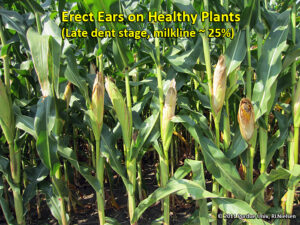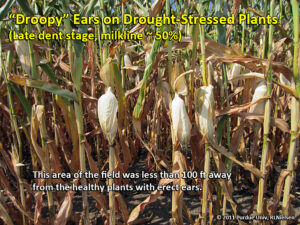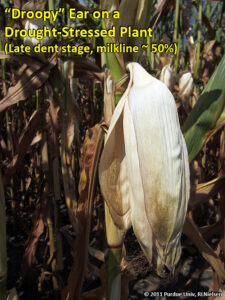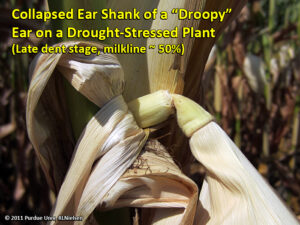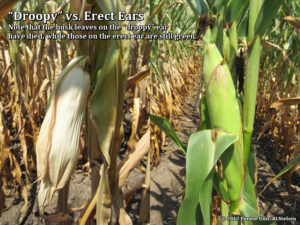Taken from Purdue Extension, Chat and Chew Cafe – September 11, 2020 – Issue 2020.24 – By Bob Nielson
Droopy ears are cute on certain breeds of dogs, but droopy ears on corn plants prior to physiological maturity are a signal that grain fill has slowed or halted. Ears of corn normally remain erect until some time after physiological maturity (black layer development) has occurred, after which the ear shanks eventually collapse and the ears decline or “droop” down. The normal declination of the ears AFTER maturity is desirable from the perspective of shedding rainfall prior to harvest and avoiding the re-wetting of the kernels. PREMATURE ear declination, however, results in premature black layer formation, lightweight grain, and ultimately lower grain yield per acre.
What Causes Premature Droopy Ears? The most common contributing factor is severe drought stress that extends late into the grain-filling period. I have seen droopy ears in quite a few fields around Indiana these past few weeks in areas afflicted with severe drought stress. Even though Indiana has not experienced a lot of excessively hot (≥ 95o F) days in 2020, drought conditions coupled with sunny days and unusually low humidity (i.e., low dew point temperatures) result in significant evapotranspiration demands on the crop during grain filling. In most of the affected fields, the severity of leaf rolling and premature leaf death (senescence) due to drought stress was also high.
The “droopy” symptom suggests a loss of turgidity in the ear shank due to stress, possibly combined with some cannibalization of the ear shank similar to what can occur with the stored reserves of the main stalk in response to severe photosynthetic stress. Eventually, the ear shank collapses and the ear droops down.
Flashback: In hybrids without the Bt-corn borer trait, collapsed ear shanks can also result from extensive tunneling by European corn borer larvae. Such tunneling weakens the ear shank, allowing it to collapse, and can ultimately also cause the ear to literally drop from the plant.
Impact on Yield? Remember that the ear shank is the final “pipeline” for the flow of photosynthates into the developing ear. An ear shank that collapses prior to physiological maturity will greatly restrict, if not totally prevent, the completion of grain fill for that ear and will likely cause premature black layer development in the grain. If the droopy ears have not yet black layered, they will black layer prematurely; sooner than neighboring erect ears.
The timing of the onset of the collapsed ear shanks determines the magnitude of the expected yield loss. If grain fill were totally shut down at the full dent stage of grain development (milk line barely visible at dent of kernels), the yield loss would be as much as 40 percent. If grain fill were totally shut down at the late dent stage of grain development (milk line halfway between dent and tip), yield losses for the affected ears would equal about 12 percent.
Multiplying the percentage of affected ears in a field by the estimated yield loss per ear will give you an estimate of whole field loss. For example, if ten percent of the field contained plants whose ears drooped prematurely at the late dent stage, whole field loss would be estimated at 1.2 percent (10 percent of the ears multiplied by 12 percent yield loss per ear).
Final thought: While it is never enjoyable assessing the yield potential of drought-stressed fields, it does serve a purpose in helping you develop your grain marketing strategy. Let this article serve as a reminder that the proverbial “windshield survey” often fails to provide an accurate assessment of crop conditions.
Related reading
Nielsen, RL (Bob). 2012. Opportunities to Assess Yield Potential of Drought-Stressed Corn. Corny News Network, Purdue Univ. http://www.kingcorn.org/news/articles.12/YldAssessment-0727.html
Nielsen, RL (Bob). 2018. Estimating Corn Grain Yield Prior to Harvest. Corny News Network, Purdue University. http://www.agry.purdue.edu/ext/corn/news/timeless/YldEstMethod.html
Nielsen, RL (Bob). 2019. Grain Fill Stages in Corn. Corny News Network, Purdue University. http://www.agry.purdue.edu/ext/corn/news/timeless/GrainFill.html
Examples of droopy ears from a field in 2011 with drought-stressed and non-droughty areas.

